This video is a slide presentation of Kinetrol actuators at work.
The Kinetrol rotary vane design is based upon a single moving part which eliminates additional parts required to convert linear motion to rotary motion. This simple and innovative design provides a highly accurate and extremely reliable actuator for operating valves, drives and dampers, and is perfectly suited for the most demanding process control applications. For more information visit www.kinetrolusa.com or call 972-447-9443.
Showing posts with label Kinetrol. Show all posts
Showing posts with label Kinetrol. Show all posts
Kinetrol Pneumatic Actuators at Work
Kinetrol rotary vane actuators are the true workhorse of the valve and damper actuation industry. Known for surviving applications with the highest cycle rates, the nastiest environments, and the most remote areas, Kinetrol actuators continue to provide years of maintenance-free service.
This video is a slide presentation of Kinetrol actuators at work.
This video is a slide presentation of Kinetrol actuators at work.
1/4 Turn Electrohydraulic Valve Actuators
A hydraulic gear pump immersed in its own reservoir delivers pressurized oil to the vane-type 90° actuator via the control box, which contains non-return valves and solenoid valves to direct the flow into the actuator; with cam operated limit switches to control travel and (optionally) signal position to the user. The unpressurized side of the actuator is connected to the reservoir, so there is no net transfer of oil from reservoir to actuator. The pump and its motor run entirely on precision ball bearings, so that the friction and motor size can be minimized and life maximized; the efficiency resulting from this reduces the heating effect and allows 100% rating. A pressure release valve is built into the pump so that if the actuator load becomes jammed the torque is limited and dangerous over pressures or motor stalls are avoided.
Fail-safe spring return action uses a reliable low-stress-range sealed clock-type spring unit mounted coaxially with the actuator, together with a fail-open solenoid valve, to ensure reliable positioning when power is not supplied to the unit. A high flow external dump valve can be fitted to allow very rapid spring-driven action.
Double-acting models are supplied with solenoids arranged to give position locking when power is disconnected. An optional manual by- pass valve is available to allow manual override movement of a double acting when power is disconnected.
The interface between pump/reservoir unit and the control box allows mounting of the pump in different orientations at 90° to each other, so that the motor can be kept above the reservoir whether the actuator output axis is horizontal or vertical. External electrical connections are all made via a single accessible connector block in the control box, with the simplest possible switching needed to drive the unit. Two conduit entries are available, to allow easy separate connection of power and signal lines (if used). All internal wiring is connected via a central connector and fuse board, and the actuator is protected from supply surges by a metal oxide varistor suppressor.
For more information contact:
Kinetrol USA
www.kinetrolusa.com
972-447-9443
Fail-safe spring return action uses a reliable low-stress-range sealed clock-type spring unit mounted coaxially with the actuator, together with a fail-open solenoid valve, to ensure reliable positioning when power is not supplied to the unit. A high flow external dump valve can be fitted to allow very rapid spring-driven action.
Double-acting models are supplied with solenoids arranged to give position locking when power is disconnected. An optional manual by- pass valve is available to allow manual override movement of a double acting when power is disconnected.
The interface between pump/reservoir unit and the control box allows mounting of the pump in different orientations at 90° to each other, so that the motor can be kept above the reservoir whether the actuator output axis is horizontal or vertical. External electrical connections are all made via a single accessible connector block in the control box, with the simplest possible switching needed to drive the unit. Two conduit entries are available, to allow easy separate connection of power and signal lines (if used). All internal wiring is connected via a central connector and fuse board, and the actuator is protected from supply surges by a metal oxide varistor suppressor.
For more information contact:
Kinetrol USA
www.kinetrolusa.com
972-447-9443
Does Your Valve or Damper Need More Than 90 Degrees Rotation?
 |
| 180 degree actuator |
Factory fitted, direct mount linkage units are available to suit model 02, 03, 05, 07, 09, 12, 14 and 16 actuators, giving a neat single unit with no mount kits or brackets. The linkage’s unique geometry gives constant 2:1 step-up so that the output torque remains constant throughout the actuator's travel.
The all-steel mechanism of the linkage employs rolling contacts to minimise frictional losses and wear, and to maximise life. The linkage is lubricated for life, and encased in a robust, fully sealed die cast alloy casing. Exterior surfaces are protected by a corrosion resistant epoxy stove enamel finish. Standard adjustable endstops on the 90 degree actuator can be used to set the angle of travel. The other end of the 90 degree actuator allows the full range of Kinetrol modular accessories to be fitted directly.
- Simple compact unit - No external moving parts
- Unique linkage design - converts to 180° travel 120° option available
- Constant gear-up ratio through travel range - Hence constant output torque
- Rolling contact linkage mechanism - Ensures low wear, long life, low friction
- Linkage sealed for life - Protected from the environment, long maintenance free life
- Compatible with all Kinetrol modules - Direct mounted spring returns, limit switch boxes, positioners etc.
- Adjustable endstops
6 Reasons Why Pneumatic Vane Actuators are Superior to Rack and Pinion Actuators
 |
| Rotary vane actuators offer distinct design and performance advantages. |
- Rotary vane actuators do not convert linear motion to rotary motion, unlike rack and pinion actuators. No additional gearing is required and no side loading is transferred to the actuator housing.
- Vane actuator lip seals are the key to long life. The double opposing lip seal design, with stainless steel expanders, provides unmatched service life by using air pressure to improve the actuators seal-to-enclosure contact, and provide a “self cleaning” effect on the epoxy or PTFE internal finish.
- The elimination of pressure bearing o-ring shaft seals. Rack and pinion actuators require shaft sealing o-rings that are exposed to the full supply air pressure used to operate the actuator. These o-rings wear, causing leaks, a drop in efficiency, and wasted energy through air consumption. Vane actuators' double opposing lip seals isolate the supply air pressure from the actuator shaft, requiring only a low friction bearing on the shaft.
- Rotary vane actuators provide superior modulating accuracy. Because of the integral vane and shaft (machine from a single casting), lost motion or hysteresis is reduced dramatically which intern provides much tighter modulation and control. The vane actuators inherent low friction also reduces hunting and sticking.
- Direct mount, modular design for springs, positioners, switches, and solenoids reduce space requirements and lower inventory costs. Since vane actuator accessories direct mount to various size actuators, there’s no need to inventory and keep track of mounting kits.
- Rotary vane actuator spring return units are designed to be virtually indestructible. Using low stress, clock springs reduces spring tension loss and metal fatigue. The housing for vane a actuator springs are sealed from the atmosphere, preventing corrosion of internal parts. Most importantly, these type of spring units provide the lowest torque loss which enables the section of smaller (less expensive) actuators.
The Virtues of the Pneumatic Vane Actuator Damper Drive
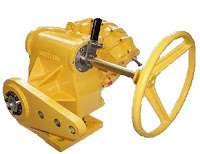 |
| Pneumatic damper drives |
Recent “Boiler MACT” (Boiler Maximum Achievable Control Technology) regulations require regular maintenance to optimize boiler performance. Air-to-fuel mixing and CO emissions are two areas where fine tuning and precise control yields dramatic improvement in burn efficiency. Old electric drives do not provide the precision, speed or torque needed for accurate control, so a retrofitting program that replaces electric drives with pneumatic units is an easy way to improve efficiency and gain better performance.
In the application outlined below, several dual-arm damper drives, using Kinetrol Model 18 actuators, were specified to replace aging Bailey electric damper drives in a power plant in the southwest USA. These specific drives are used to control the desuperheater and reheater temperature at a gas fired plant. Not only was there a need for optimized performance for better fuel consumption and lower emissions, but the customer was also very concerned about reliability. The plant needed to know the new Kinetrol-based damper drives were immediately available, and ready for drop-in replacement as the Bailey drives failed. This was easily managed by designing pedestals and frames that matched the bolting patterns and envelope size of the existing Bailey units. The Kinetrol drives were designed to match the legacy footprint exactly, have the drive shaft and drive lever in the exact position, and provide a drive shaft and lever with the same dimensions as the Bailey drive.
The result is a high duty cycle, highly precise, long-life, fast acting, responsive, easily maintained, and easily automated damper drive.

The Principles of Rotary Actuators
 |
| Variation of the rotary actuator. (Kinetrol pneumatic vane actuator.) |
A true rotary actuator produces work by direct action of fluid pressure against internal vanes. Work is defined as a force applied over a distance. Rotary actuators produce a special type of rotational work called torque.
Torque occurs when a force acts on a radius. Since rotary actuators operate at low speed with high torque, torque output rather than the horsepower is used for the rating and identification purposes. Speed is a secondary consideration when choosing a rotary actuator for a particular application.
The typical units of measurement for torque are foot pounds (lb·ft). For example, if a rotary actuator with an arm length or radius of two feet were used to lift the two hundred-pound weight, then the resultant torque required to accomplish the work would be 400 lb·ft.
Understanding the relationship between the output torque required and the physical set up a fluid system enables designers to determine the appropriate rotary actuator for each unique application.
The following video does an excellent job of illustrating the mechanics and the physics behind rotary actuators.
Water Recycling Application at Iron Ore Mine
 Mining corporations need water - a lot of water - to make bare rock give up its valuable minerals.
Mining corporations need water - a lot of water - to make bare rock give up its valuable minerals.Water is used for the extraction of minerals that may be in the form of solids, such as coal, iron, sand, and gravel. The category includes quarrying, and milling (crushing, screening, washing, and flotation of mined materials).
Not only is water used to expose the mineral, it must be carefully managed to prevent the release of contaminated water back into the environment.
There are multiple processes involving the management of water that require piping, valves and automation for water management.
- The reuse of water used to extract the minerals from the other solids.
- Managing surface water from rain, snow, and streams.
- Capturing and recycling water from the mine site.
- Storing water in evaporation ponds.
The Distributor designed and provided this characterized butterfly control valve, with a Kinetrol actuator, pneumatic positioner, and cone indicator. The valve is used to recycle processed water back into the plant for reuse in the extraction process. The valve and actuator experiences a very high cycle rate (400 cycles per day).
Intercepting and diverting surface water
- Intercepting and diverting surface water (rain and snowmelt runoff, streams, and creeks) from entering the mine site by building upstream dams to reduce the potential for water contamination from exposed ore and waste rock
- Recycling water used for processing ore in order to reduce the volume of water requiring treatment
- Capturing drainage water from precipitation at the mine site through the use of liners and pipes and directing the water to tailings dams in order to prevent potentially contaminated water from entering groundwater or flowing off site
- Allowing the water to evaporate in ponds to reduce the volume of contaminated water; in dry regions, enough water may be evaporated that no water needs to be discharged, resulting in the containment of contaminates at the mine site
- Installing liners and covers on waste rock and ore piles to reduce the potential for contact with precipitation and contamination of groundwater
Segment Ball Control Valve with Vane Actuator, Pneumatic Positioner, and I/P Transmitter
 |
| Actuator and Positioner |
In most cases standard ball, plug, or butterfly valves are not the best choice as control valves (where the process media has to be modulated or throttled). Standard ball, plug and butterfly valves usually introduce very non-linear, dynamic flow coefficients. Furthermore, they can introduce undesirable turbulence to your piping system.
As a means to linearize flow coefficients and reduce turbulent flow, the machining, or characterization, of the valve disk is done so that the machined shape allows for more optimized flow.
For ball valves in particular, machining the ball's flow port with a "V", or even by machining the ball more radically, can deliver excellent flow curves. A term for a more radically machined ball is the "segment ball" (sometimes called "segmented"). In the following video you can see how a Kinetrol pneumatic actuator, postioner, and I/P transmitter team up with a segment ball valve foe an excellent control valve.
Labels:
actuation,
automation,
ball,
butterfly,
control valve,
Kinetrol,
plug,
segment,
V port,
valve
Very High Cycle, Coal Power Plant Butterfly Valve Application
 |
| One moving part. Simply the best. |
A coal fired power plant was using old Powell gate valves with dual air cylinders and volume tanks. Because of high cycle rate (the valve cycles open/closed every 30 seconds), the Powell gate valves were breaking down constantly - leaking at first, then failing. Downtime for repair was costing a fortune.
A local Kinetrol Distributor was called in to recommend a better solution. After discussing the capabilities of Kinetrol, the power plant decided to replace the gate valves with 6" high performance butterfly valves actuated with Kinetrol size 12 actuators, spring returns and limit switch packages.
A local Kinetrol Distributor was called in to recommend a better solution. After discussing the capabilities of Kinetrol, the power plant decided to replace the gate valves with 6" high performance butterfly valves actuated with Kinetrol size 12 actuators, spring returns and limit switch packages.
The result was a robust valve/actuator package that could handle the 120 cycles per hour required - truly a difficult application. As of two years in operation, both valve and actuator have been running reliably much to the delight of the power plant maintenance crew.
 |
| High cycle coal fired power plant Kinetrol / HPBV application. |
Innovative Approach to Add Manual Failsafe Handles for Large Quarter-Turn Valves
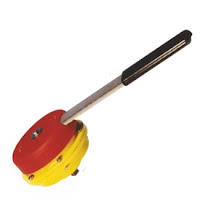 |
| Kinetrol manual failsafe unit |
Here's an innovate and effective way to incorporate a manual failsafe unit on large size ball, butterfly, or plug valves.
Retrofit your large valve with a 3-way "L" port ball valve and a manual failsafe spring handle on the large valve actuator's inlet air supply port.
This allows the opening of the valve with the manual failsafe handle. When the handle is released, the valve shuts automatically by venting the air to atmosphere, and allowing the springs in the actuator to close the valve.
Size limitations on the valves are no longer an issue, and this will work on anyone's pneumatic spring return actuator (spring return required, will not work on double acting actuators).
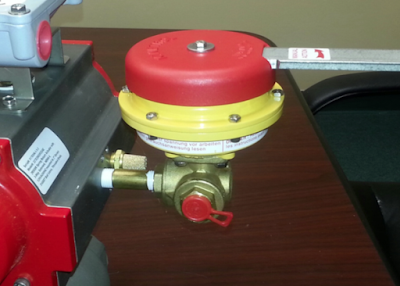 |
| Manual Override for Larger Valves |
Limit Switches for Your Rotary Vane Actuator in Hazardous Areas
This Explosion Proof Limit Switch Box offers a wide range of signaling options in a compact corrosion resistant aluminum alloy housing available for close - mounting onto Kinetrol actuators or discrete mounting via a Kinetrol 05 square or industry standard VDI/VDE interface onto any make of rotary actuator. Easy to wire and set up with true industrial robustness.
Internally fitted options include AS interface digital communication and a 4-20mA, 2-wire, modulating angle retransmit circuit. The range of switches and terminal arrangements includes 2 or 4 switches and extra connections - allowing single point termination of wiring for limit switches and solenoid valves. This product is available to mount on Kinetrol models 03 - 30.
Internally fitted options include AS interface digital communication and a 4-20mA, 2-wire, modulating angle retransmit circuit. The range of switches and terminal arrangements includes 2 or 4 switches and extra connections - allowing single point termination of wiring for limit switches and solenoid valves. This product is available to mount on Kinetrol models 03 - 30.
Kinetrol Actuators Chosen to "Bust Myths" on Popular TV Show
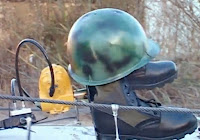 |
| A mechanical "soldier" busting myths. |
Case in point, the very popular science entertainment show "MythBusters" (produced for the Discovery Channel).
In an episode challenging the concept of destructive harmonics caused by an army marching in unison, MythBusters decided to create an "army" of mechanical feet to march in over a mock bridge. An important requirement was a mechanical rotational movement device that would allow for synchronized movement (simulating the legs of soldiers). Accurate and smooth control of multiple actuators so the cadence could be controlled was crucial. Enter Kinetrol.
To see a 4 minute clip of the setup, test and results, see Kinetrol in action on the Breakstep Bridge Minimyth here.
Below are some images from the broadcast.
 |
| The "army" of marching feet. |
 |
| One of the test rigs. |
Pneumatic Actuator with 180 Degree Rotation for Your Multi-Port Valve
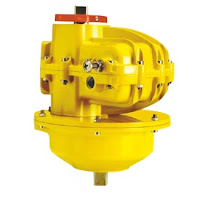 |
| 180 degree actuator for multi-port valves. |
So you need a pneumatic actuator with more than 90 degrees of rotation - most likely for a multi-port valve, or a custom louver or damper. Here's an excellent solution.
Kinetrol vane actuators provide factory fitted, direct mount linkage units for their models 02, 03, 05, 07, 09, 12, 14 and 16 actuators, giving a neat single unit with no mount kits or brackets. An added benefit is the linkage’s unique geometry gives constant 2:1 step-up, so that the output torque remains constant throughout the actuator's travel.
The all-steel mechanism of the linkage employs rolling contacts to minimize frictional losses and wear, and to maximize life. The linkage is lubricated for life, and encased in a robust, fully sealed die cast alloy casing. Exterior surfaces are protected by a corrosion resistant epoxy stove enamel finish.
The all-steel mechanism of the linkage employs rolling contacts to minimize frictional losses and wear, and to maximize life. The linkage is lubricated for life, and encased in a robust, fully sealed die cast alloy casing. Exterior surfaces are protected by a corrosion resistant epoxy stove enamel finish.
Standard adjustable end-stops on the 90 degree actuator can be used to set the angle of travel. The other end of the 90 degree actuator allows the full range of Kinetrol modular accessories to be fitted directly.
120 degree actuators are also available with adjustable end stops to give up to 133°.
120 degree actuators are also available with adjustable end stops to give up to 133°.
Keeping Critical Turbine Lubrication Flowing
 |
| Lube filter diverters (courtesy of Kinetrol USA) |
Two 3-way valves and pneumatic actuators are used to re-direct flow between between two lube filter housings. The valve and actuator must be extremely reliable as a failure requires the turbine shutting done.
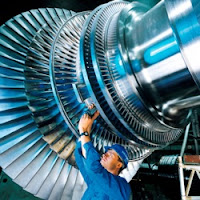 |
| Steam Turbine (courtesy of Wikipedia) |
Kinetrol Actuator on Asphalt Plug Valve
 |
| Kinetrol actuator on asphalt valve. |
The service is extremely nasty, as the asphalt is hot, sticky and gets everywhere. The Kinetrol actuators were installed on 3” Homestead liquid asphalt plug valves with extended brackets and couplings to prevent the actuators from seeing over-temperatures. The valves are cycled 10 times per day.
Since the summer of 2014 they have installed 5 Kinetrol actuators and all are working without problems. The initial results are so positive the customer plans to standardize on Kinetrol Vane Actuators, and replace the rack and pinion actuators as they fail.
Bi-directional Positioning of Large Dampers Using Rotary Actuators and Declutchable Manual Override Gearbox
 |
| Rotary Actuator with declutchable manual override gearbox |
One common application for bi-directional rotary actuators is the positioning of large damper valves controlling the flow of air and other gases along ducting in power generating plants. These dampers are often inaccessible, so it is not possible to install drives immediately adjacent the valve. In such circumstances, the rotary actuator drives the damper valve via a mechanical linkage. The rotary actuator will, in most cases, be used in conjunction with a position controller to provide for accurate control of the position of the damper valve.
 In this, and other applications of rotary actuators, it can sometimes be desirable to provide for manual adjustment of the position of the actuator, for example during the initial set-up of a mechanism, or on failure of automatic actuator function. This is generally accomplished by using a so called declutchable manual override gearbox. The gearbox is mounted adjacent to the actuator and is connected to the output of the actuator. Drive is transferred via the gearbox to a drive shaft connected to the gearbox output. The gearbox includes a manually operable override, typically a wheel or lever, selectively engageable with the drive train in the gearbox. In normal operation, this manual override is de-clutched from the drive train. However, if it is desired to manually adjust the position of the actuator and the mechanism it drives, the manual override can be engaged.
In this, and other applications of rotary actuators, it can sometimes be desirable to provide for manual adjustment of the position of the actuator, for example during the initial set-up of a mechanism, or on failure of automatic actuator function. This is generally accomplished by using a so called declutchable manual override gearbox. The gearbox is mounted adjacent to the actuator and is connected to the output of the actuator. Drive is transferred via the gearbox to a drive shaft connected to the gearbox output. The gearbox includes a manually operable override, typically a wheel or lever, selectively engageable with the drive train in the gearbox. In normal operation, this manual override is de-clutched from the drive train. However, if it is desired to manually adjust the position of the actuator and the mechanism it drives, the manual override can be engaged.
A Cheesy Application for a Kinetrol Actuator & Positioner
 |
| Kinetrol Actuator, Positioner and Spring on Steam Line in Cheese Making Plant |
Its a tough application, and critical to keep running. Losing steam supply is very costly because of production losses and access to the valve is difficult.
The plant maintenance people tried a few of the more well-known valve/actuator packages without success. These packages would last a few weeks (a couple months at best), before failing. Frustrated and out of answers, the maintenance crew turned to a local Kinetrol Distributor salesperson for advice.
Knowing Kinetrol actuators, spring units and positioners are designed for the toughest applications, the salesperson specified the 097-120 on top of a Triad v-ported ball valve. Hopeful, but with little optimism, the maintenance crew installed the 1-1/2 control valve on the steam line and fired the system up.
For 11 months now (without any downtime), 24 hours a day, this lonely control valve, powered by a Kinetrol positioner and vane actuator, accurately throttles the steam supply and reliably keeps the cheese process line running.
Problem solved by Kinetrol!
The Kinetrol Universal Limit Switch
The Kinetrol universal limit switch box offers a wide range of signa ling options in a zinc alloy fully enclosed corrosion resistant case available for direct mounting onto Kinetrol rotary actuators,
or discrete mounting via an industry standard VDI/VDE interface onto any make of rotary actuator. Easy to wire and set up with real industrial-quality robustness. - Internally fitted options include AS interface digital communication and a 4-20 mA 2-wire modulating angle retransmit circuit.
or discrete mounting via an industry standard VDI/VDE interface onto any make of rotary actuator. Easy to wire and set up with real industrial-quality robustness. - Internally fitted options include AS interface digital communication and a 4-20 mA 2-wire modulating angle retransmit circuit.
An Extremely Accurate and Precise Valve Positioner
The EL electropneumatic positioner combines the precision and adaptability of a digital electronic control circuit with the smoothness and efficiency of Kinetrol's proven proportional servo valve, to give the best available 4-20mA positioning performance from rotary pneumatic actuators.
Features
This unbeatable performance is combined with the easiest available setup procedure, easiest access to all functions and options, easy connectibility, and a truly compact all-metal enclosure, plus unique easy-set isolated angle retransmit and limit switch options inside the same enclosure.
Features
- Fast, smooth and precise control from a digital circuit and proportional servo valve
- Simple time saving field set up
- Quick calibration via push buttons and LED feedback and easy reversal of rotation sense (clockwise/counter clockwise) without special tools or parts change.
- Universal application
- The unit can be mounted in any orientation on to any quarter turn or linear application by connection via a NAMUR or Kinetrol square interface.
- Loop powered
- No separate power needed, just a 4-20mA signal plus air supply.
- Integral options - easily retrofitted modules include:
- Two wire 4-20mA isolated angle retransmit
- Mechanical or inductive position indicator switches (general or hazardous areas)
- Clear Cone high visibility indicator
- Threaded conduit entries or DIN plugs for external connection.
- Intrinsically safe approved options
- Weatherproof, compact and robust metal housing
- Zero backlash coupling with easily adjustable switch strikers
- Vibration and shock resistant to 4G
- Built in gauge ports/external connections
Why Kinetrol Pneumatic Vane Actuators Are Superior in Design - in 20 Sec...
It's a bold statement, but it's backed up with decades of proven performance, millions of actuators in the field, and many happy customers.
Kinetrol USA
1085 Ohio Drive
Plano, Texas 75093
(972) 447-9443 phone
(972) 447-9720 fax
sales@kinetrolusa.com
- Single moving part - Simplest and most reliable mechanism for quarter-turn rotary actuation.
- Close couple control modules - Fail-safe spring returns, limit switches, positioners and solenoid valves all close couple to the actuators.
- No cranks or gearing - No power loss or backlash - allows accurate positioning.
- Durable corrosion resistant finish
- Long maintenance-free life - Up to 4 million operations guaranteed.
- Compact - space saving - efficient - Best torque/size package available, fast operating speeds, best air consumption, proven design.
- Millions of units in trouble free service all over the world
- Choice of male or female output drive square - easy to interface to application
- Unique serial number for identification and traceability
Kinetrol USA
1085 Ohio Drive
Plano, Texas 75093
(972) 447-9443 phone
(972) 447-9720 fax
sales@kinetrolusa.com
Subscribe to:
Posts (Atom)

